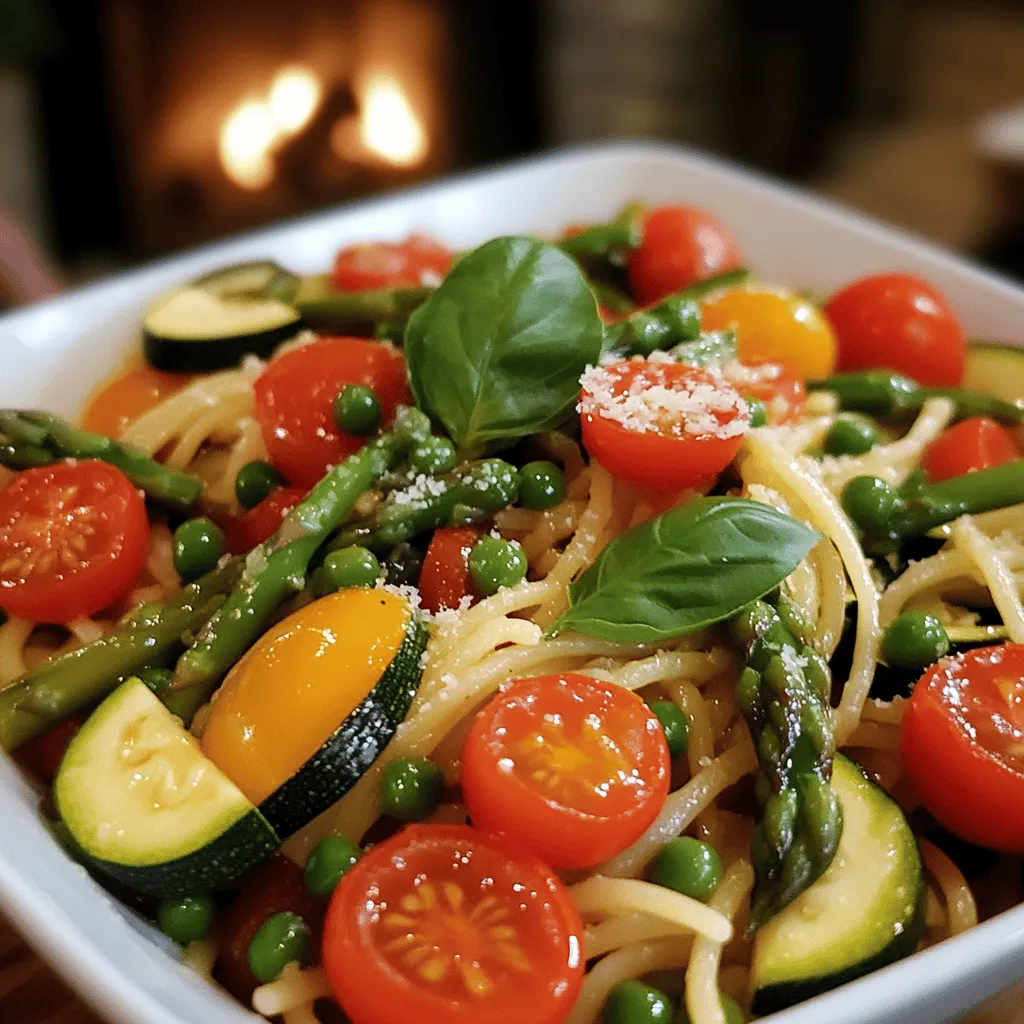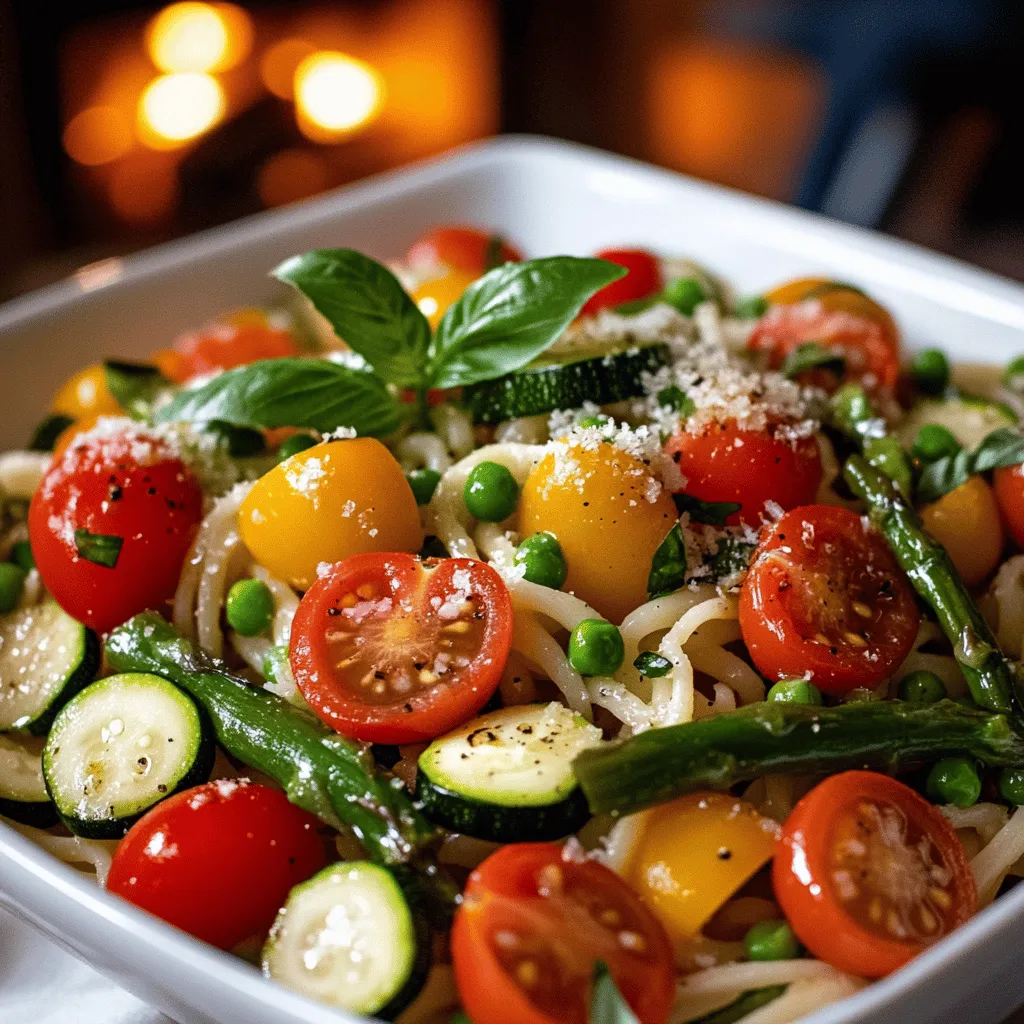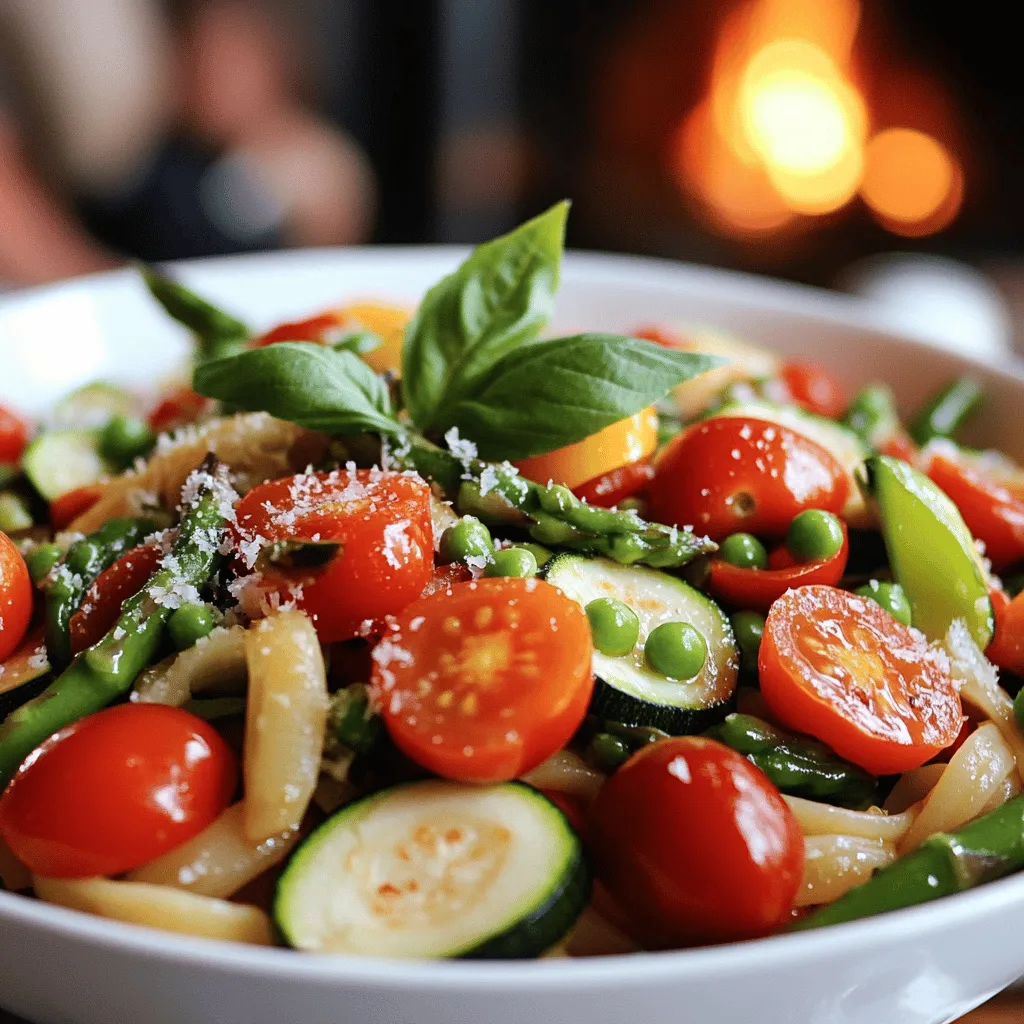Spring is here, bringing a burst of fresh vegetables perfect for pasta primavera! This vibrant dish celebrates the season with colorful veggies and simple flavors. You can easily craft a meal that’s both nutritious and delicious. In this guide, I’ll reveal essential tips, the best ingredients, and exciting variations. Let’s dive into how to create your own Spring Vegetable Pasta Primavera that’ll impress everyone at your table!
What Are the Key Ingredients for a Perfect Spring Vegetable Pasta Primavera?
To create a great spring vegetable pasta primavera, focus on fresh, seasonal ingredients. The best spring vegetables for pasta include asparagus, zucchini, bell peppers, cherry tomatoes, and peas. These vegetables bring bright colors and flavors to your dish. You can find them in local markets during springtime.
Which Seasonal Vegetables Work Best?
Asparagus shines in spring. Its crisp texture adds a nice crunch. Zucchini is tender and mild, making it a perfect match. Bell peppers offer sweetness and color. Cherry tomatoes burst with flavor and acidity. Fresh peas add a pop of sweetness. You can mix and match these veggies based on what you like or what you find fresh.
How Do I Choose the Right Pasta Type?
Choosing the right pasta is essential. Spaghetti, fettuccine, or penne works well for pasta primavera. Each pasta type holds sauce differently. Spaghetti twirls nicely with the veggies, while penne scoops them up. Choose what you enjoy most, and cook it according to the package instructions.
What Essential Herbs and Spices Enhance the Flavor?
Herbs and spices make a big difference. I recommend using fresh basil for a fragrant touch. Dried oregano adds depth to the dish. If you like heat, use red pepper flakes for a kick. Salt and pepper enhance all the flavors. Use these ingredients to elevate your pasta primavera. For the full recipe, check the details above.
How Do I Prepare the Spring Vegetable Pasta Primavera?
To make easy pasta primavera with vegetables, start with the pasta. First, boil water in a large pot. Add salt for flavor. Then, cook the pasta according to the package guide. When it’s ready, drain it but save some pasta water. This helps later.
Next, grab a large skillet and add olive oil. Heat it over medium heat. Once warm, toss in minced garlic. Sauté until it smells good, about one minute. Then, add zucchini, bell pepper, and asparagus. Cook these for about three to four minutes. They should be soft but still bright.
After that, add the cherry tomatoes and peas to the skillet. Cook for another three to five minutes. You want the veggies tender but not mushy. Pour in the vegetable broth next. Add the dried oregano and red pepper flakes if you like spice. Let it simmer for three minutes to blend the flavors.
Now, mix in the cooked pasta. Add a bit of reserved pasta water to create a light sauce. Stir well to combine everything. If it feels dry, add more pasta water until it’s just right. Season with salt and pepper to taste.
Serve the pasta warm. Top it with fresh basil leaves and sprinkle Parmesan cheese on top if you want. For the full recipe, check the detailed instructions above. Enjoy your fresh and colorful spring dish!

What Variations Can I Try with Pasta Primavera?
Pasta primavera is a dish that welcomes creativity. You can easily change it to suit your taste. For a vegan pasta primavera recipe, swap the cheese for nutritional yeast or omit it altogether. This adds a cheesy flavor without dairy.
For a gluten-free pasta primavera recipe, use gluten-free pasta made from rice or quinoa. It cooks well and tastes great with fresh veggies.
You can also add different vegetables based on what you find at the market. Consider using broccoli, carrots, or spinach. Each brings a unique flavor and texture.
How Can I Customize the Recipe for Dietary Preferences?
To make pasta primavera fit your diet, try different pastas and veggies. If you’re gluten-free, ensure your pasta choice is safe. For a low-carb option, use spiralized zucchini or spaghetti squash instead of traditional pasta.
If you’re vegan, replace the Parmesan cheese with a blend of nuts and seeds. This adds richness without animal products.
What Protein Options Can I Incorporate?
Adding protein boosts the dish’s nutrition. Grilled chicken, shrimp, or tofu are great choices. For a plant-based option, chickpeas or lentils add protein and fiber.
Simply sauté them with the veggies to infuse the flavors.
Are There Any Unique Ingredient Swaps for More Flavor?
To enhance the taste, try using fresh herbs like basil or parsley. These add brightness and freshness.
You can also swap vegetable broth for a splash of white wine. This gives the dish a deeper flavor.
Experiment with different spices, such as smoked paprika or lemon zest. These ingredients elevate the taste and make your pasta primavera unique.
For the full recipe, check out the details above. Enjoy customizing your dish to match your style!
What Are Some Cooking Tips for a Flavorful Pasta Primavera?
To make a great pasta primavera, focus on fresh, vibrant veggies. Use seasonal produce for the best taste. Bright colors add life to your dish. When you choose your vegetables, aim for a mix of textures and flavors.
How Can I Avoid Soggy Vegetables?
To prevent soggy vegetables, cook them quickly. Start by sautéing on medium heat. Keep the veggies crisp by stirring often. Cook just until tender. This usually takes about 3-5 minutes. You want them to stay bright and colorful.
What Tips Work Best for Enhancing the Overall Flavor Profile?
To enhance the flavor, use fresh herbs and spices. Oregano and red pepper flakes add warmth and depth. Garlic brings a lovely aroma. Don’t forget to season with salt and pepper. A splash of lemon juice at the end brightens the dish.
How Do I Achieve a Creamy Pasta Primavera Sauce?
To create a creamy sauce, add a bit of reserved pasta water. This starchy water helps bind the dish together. You can also stir in some cream or a dairy-free option if you like. This adds richness without overpowering the fresh flavors. For the full recipe, check out the detailed instructions.

How Can I Serve and Present Pasta Primavera Creatively?
Serving pasta primavera can be fun and colorful. To make it pop, use a large, white plate. The bright colors of the veggies stand out nicely against the white. You can twirl the pasta into a nest shape for height. Place the veggies on top for a vibrant look.
For garnishes, fresh basil leaves add a nice touch. You can also sprinkle grated Parmesan cheese on top. A drizzle of good olive oil gives a shine. For a bit of crunch, toasted pine nuts work well, too.
Pairing pasta primavera with wine enhances the meal. A light, crisp white wine like Pinot Grigio matches nicely. It brings out the fresh flavors of the veggies. If you prefer non-alcoholic drinks, try sparkling water with lemon.
If you want sides, a simple green salad works well. A fresh cucumber and tomato salad adds more color. Garlic bread is another great option. It provides a nice crunch and a way to scoop up the pasta.
For kids, making the dish fun is key. You can cut the veggies into fun shapes. Use cookie cutters for stars or hearts. This makes the dish more appealing. Adding a bit of cheese on top can also win them over. You can even offer a side of marinara sauce for dipping.
For more ideas, check out the Full Recipe.
What Should I Know About Meal Prep and Storage for Pasta Primavera?
Meal prep for pasta primavera is simple and fun. You can chop vegetables the day before. Store them in airtight containers in the fridge. This step saves time and keeps your veggies fresh. If you plan to cook the pasta ahead, keep it separate. Mix it with a bit of oil to prevent sticking.
To store leftover primavera pasta, wait until it cools. Place it in a container with a tight lid. It can last in the fridge for up to three days. When you reheat it, add a splash of broth or water. This keeps the dish moist and tasty.
Can I freeze the dish for later use? Yes, you can! Just make sure to cool it first. Use a freezer-safe container. Pasta primavera can freeze well for up to three months. When you want to eat it, thaw it in the fridge overnight. Reheat on the stove or in the microwave, adding a bit of broth if needed.
By planning ahead, you can enjoy this fresh, flavorful dish any time. For the full recipe, check the details above.
In this article, we explored how to make a perfect spring vegetable pasta primavera. We discussed the best seasonal vegetables, the right pasta types, and essential herbs and spices. I also shared step-by-step cooking instructions, variations, and tips to enhance flavor. You can create a beautiful presentation to impress anyone. Lastly, I covered meal prep and storage tips. With these ideas, you can enjoy and share this tasty dish all spring long. Happy cooking!


